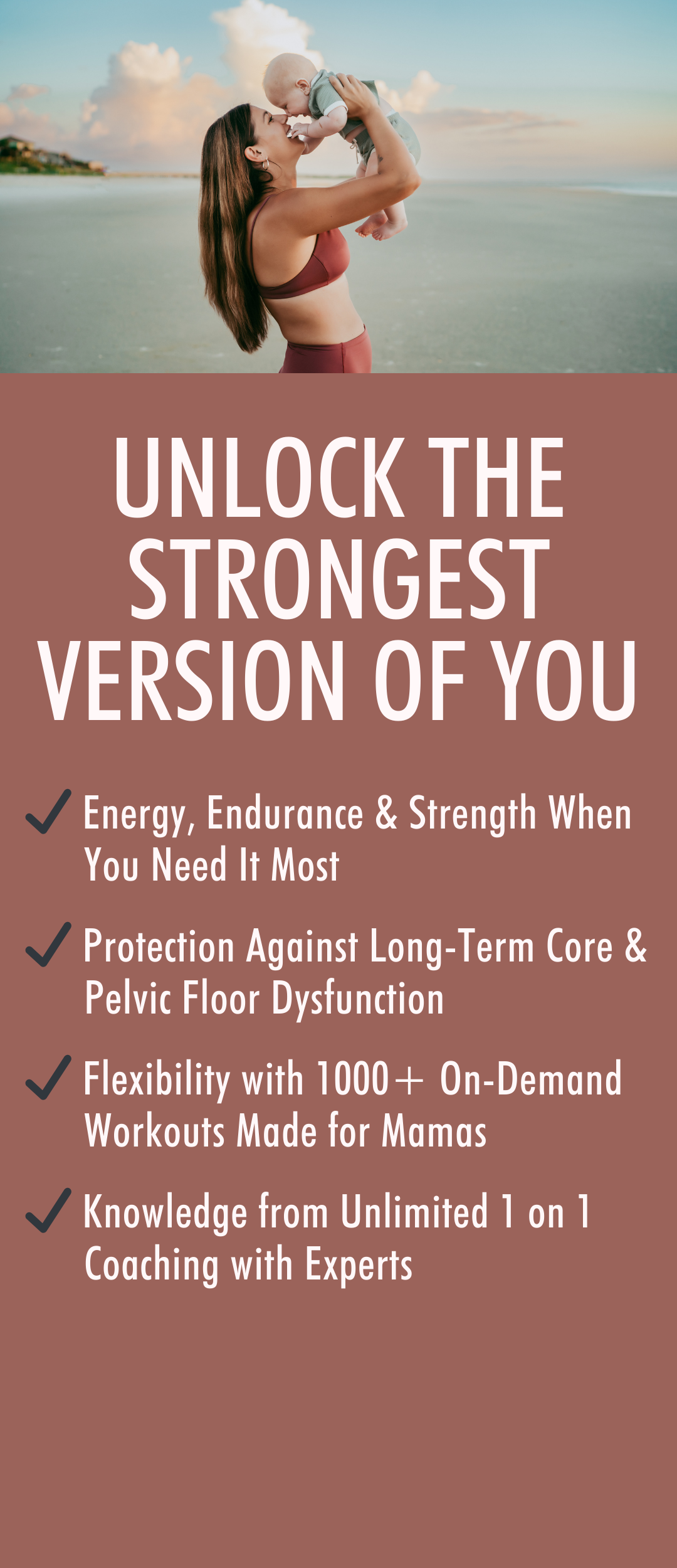Why Diastasis Recti Doesn’t Have To Be A Guaranteed Pregnancy Injury + How To Check For It

Diastasis recti is one of the most talked-about conditions that pregnant or postpartum moms experience. You might have heard about diastasis recti through a casual conversation with a friend, during a doctor's appointment, or via a Google search about the "mommy pooch."
Unfortunately, conversations about diastasis are usually coupled with confusion, fear, or misconceptions. Women are constantly told to expect a "mommy tummy" after pregnancy, along with other health issues such as urinary incontinence and pelvic organ prolapse.
But with proper preparation and birth training, diastasis recti and other pregnancy-related injuries do not have to be the main narrative of your motherhood journey.
That said, it's completely understandable to have concerns about this condition — whether you're currently conceiving, a postpartum mama, or a seasoned parent. Maybe you're wondering if you have diastasis recti or looking for better methods to self-assess your condition.
If so, we've got you covered. In this article, we're going to address some of the most common misconceptions about diastasis recti. We'll also explore more comprehensive techniques that you can use to find out whether you have diastasis recti yourself.
What is Diastasis Recti?
Diastasis recti is a common condition in pregnant and postpartum mothers. It is the separation (or diastasis) of the rectus abdominis muscles, which we call the "six packs." [1]
Your rectus abdominis, often called your six-pack muscles, are divided into the left and right sections by a band of fibrous tissue called the linea alba. During pregnancy, your abdominal wall becomes larger to accommodate your growing baby. As the baby grows, the intra-abdominal pressure increases and pregnancy hormones begin to kick in. These occurrences extend the linea alba and separate the rectus abdominis muscles. [2].
For some mothers, this tissue may lose its elasticity after being stretched out, and the gap between the six-pack muscles doesn't close naturally after they've given birth. This leads to the condition called diastasis recti. If you have this condition, you may notice a pooch or bulge that appears to stick out right above or below your belly button.
While it isn't life-threatening, diastasis is associated with core function issues, lower confidence, lower back discomfort, pelvic organ prolapse, and urinary incontinence [1].
Does Diastasis Recti Happen to Everyone?
Some research suggests that up to 100% of pregnant women experience diastasis recti during the third trimester [3].
Studies also show that diastasis recti isn't limited to the pregnancy stage, as up to 53% of women experience it right after delivery [3]. Meanwhile, around 60% of women have diastasis recti that persists six weeks into the postpartum period [1].
This may sound concerning since diastasis recti seems to be part and parcel of every motherhood journey. However, it's crucial to understand that some degree of abdominal separation is perfectly natural and normal during pregnancy.
After all, our wonderful bodies are intricately designed to bear children. So, it's no surprise that the abdomen will stretch to provide space for your growing baby!

Differentiating Natural Separation from Injury-Level Diastasis
At Studio Bloom, we make it a point to differentiate between natural separation and injury-level diastasis. This helps mothers reframe their expectations about their post-delivery bodies.
As long as the linea alba is well-protected during pregnancy and the postpartum period, the separation of the abdominal muscles can be considered healthy and completely normal.
So, what differentiates completely natural separation from diastasis recti during pregnancy?
Well, the fascinating thing about a mother's body is its incredible capability to undergo restoration and healing after pregnancy and childbirth. Once delivery has occurred, the stretched linea alba can regenerate and come back together. It's very elastic and can retract back into place, closing the gap between the muscles [4].
Though some degree of diastasis has occurred, this situation should not be classified as a case of diastasis recti, as there is no injury component with the natural separation of the abdominal muscles.
However, in some situations, the linea alba isn't protected and becomes over-weakened. As a result, it doesn't come back together as it should, and the left and right sides of the six-pack muscles remain separated. This is a true case of diastasis recti. Mamas who experience this condition often notice a "mommy pooch" and require more time for rehabilitation and healing.
Of course, mothers who experience diastasis aren't at fault. Many mamas were not well-informed about how diastasis recti can happen and how they can prevent the over-weakening of the linea alba.
If you're looking for support and guidance in managing such injuries, Studio Bloom can help you prevent and heal diastasis-related injuries through custom-designed workouts and guided programs.
How to Self-Check for Diastasis Recti
A common method used to self-check for diastasis recti is by palpating the midline during a headlift test. During this test, you'll use your fingers to feel for a gap between the rectus abdominis muscles. If the width of the gap (inter-recti distance) is two or more fingers wide, this is thought to be an indicator of diastasis recti.
At Studio Bloom, we encourage our mamas to go beyond this by measuring the depth of the gap and checking the integrity of midline connective tissues.
Plus, research studies have shown that measuring the depth and integrity of the linea alba in conjunction with the inter-recti distance can be a more comprehensive way to determine the degree of abdominal separation [1].
Here's a more comprehensive 3-step test for checking if you have diastasis recti:
Phase 1: The Upgraded Headlift
The following steps explain the first phase of self-testing for diastasis recti:
Lie on your back with your feet flat on the floor and your knees bent. One hand can go behind your head for support.
Lift your head and neck slightly off the floor as you palpate your midline. Feel for the distance between the left and right ridges of the rectus abdominis muscles.
Get a good sense of how the linea alba tissue feels, and check for the depth, tightness, and tension of the gap.
Repeat this test, but roll up 1-2 inches higher.
Repeat this test a third time, but with your head, neck, and shoulders lifted off the ground this time round.
You can perform this entire phase twice, once with a non-activated core and another time with an engaged core and contracted pelvic floor muscles.
Notice how your midline feels during each headlift test. It should become more shallow with each lift (which might seem like the gap is closing), especially once you engage your core and contract your pelvic floor muscles. If you don't feel any increasing tension with the second and third lifts, this could be a sign of a weakened linea alba.
Phase 2: Loaded Core Test
The loaded core test involves palpating your midline while you're performing a loaded core movement, such as alternating heel taps or dead bugs.
Measure the tightness and integrity of your midline as you perform the entire range of motion. If it changes at any point, this could be something to address as you work on healing your diastasis recti.
Phase 3: Function Movement Test
Phase 3 involves palpating your midline as you perform a functional movement test, such as squats or single-leg exercises.
All three phases of this self-test help you check how your midline connective tissue responds to different types of movement. It also helps you comprehensively measure the width and depth of your abdominal separation and check the tautness, integrity, and firmness of your midline connective tissue.
By performing this test, you'll also better understand your healing journey and how well you're recruiting the core and managing IAP. Both these components are vital pieces of the puzzle to healing natural and injury-level diastasis.
We'll discuss core engagement and IAP management in the next section.

How Can I Prevent or Heal Diastasis Recti?
Research shows that exercises helping women re-train their movements and regulate their IAP can be instrumental in diastasis recti prevention and healing [1]. This typically involves two main components: diaphragmatic breathing and proper core engagement.
At Studio Bloom, we coach and encourage mamas to tap into the transformative power of diaphragmatic breathing. Shifting your breath to come from your diaphragm rather than your chest is one of the best ways to deal with pregnancy discomfort and maintain your overall wellness. This form of breathing is also the first step in IAP regulation.
The next key to maintaining IAP is proper core recruitment, in combination with the ability to load the spine and maintain core engagement throughout your exercises and daily movements. Training your core is a game-changer in pregnancy and can help manage the increase in IAP. That said, good core engagement can be tricky to achieve, as it involves a delicate balance between tightening and softening the core unit.
If you're looking to heal or prevent diastasis recti, it's crucial that you learn to engage your core, breathe correctly, and apply these techniques to your everyday movements. The Bloom Method covers both diaphragmatic breathing and proper core engagement in our guided programs, empowering you to prevent pregnancy "side effects" and attain desirable outcomes throughout your motherhood journey!
References
[1] Laframboise, F. C., Schlaff, R. A., & Baruth, M. (2021). Postpartum Exercise Intervention Targeting Diastasis Recti Abdominis. International journal of exercise science, 14(3), 400–409.
[2] Radhakrishnan, M., & Ramamurthy, K. (2022). Efficacy and Challenges in the Treatment of Diastasis Recti Abdominis-A Scoping Review on the Current Trends and Future Perspectives. Diagnostics (Basel, Switzerland), 12(9), 2044. https://doi.org/10.3390/diagnostics12092044
[3] Thabet, A. A., & Alshehri, M. A. (2019). Efficacy of deep core stability exercise program in postpartum women with diastasis recti abdominis: a randomised controlled trial. Journal of musculoskeletal & neuronal interactions, 19(1), 62–68.
[4] Michalska, A. (2018). Diastasis recti abdominis — a review of treatment methods | Michalska | Ginekologia Polska. https://journals.viamedica.pl/ginekologia_polska/article/view/56088





